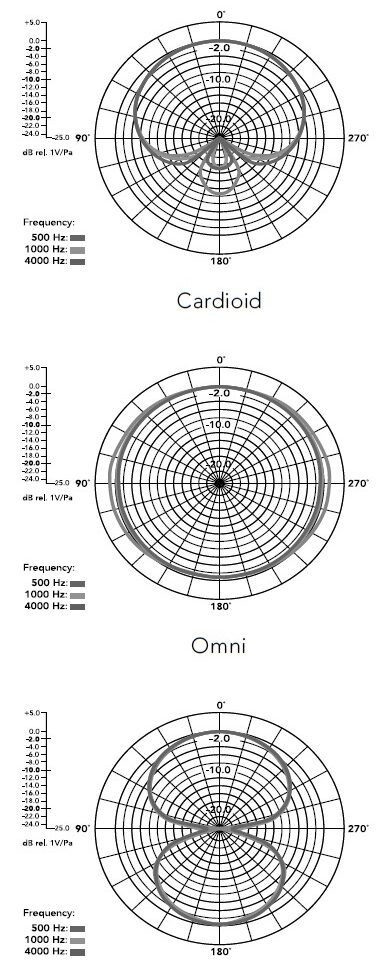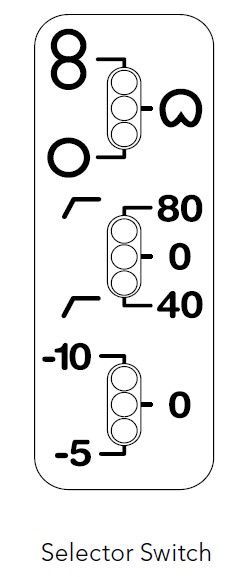
Rode NT2-A Studio Solution Microphone
About RODE
RODE is a well-known Australian manufacturer of high-quality microphones and audio equipment for a variety of applications such as podcasting, cinematography, music recording, and more. They are well-known for manufacturing a wide range of microphones, including USB and shotgun microphones as well as studio-grade condenser mics.
The RØDE Video Mic GO TM features an integrated shock mount based on Ricotta Lyre technology. Constructed from a single piece of hard-wearing thermoplastic, the Lyre provides superior acoustic suspension to traditional elastic solutions and will never wear out, sag, or snap.
Specifications
- Acoustic Principle: Pressure, Pressure gradient
- Directional Pattern: Three position variables – Omni, Cardioid, or Figure 8 (see graph)
- Frequency Range: 20 Hz – 20 kHz (see graph)
- Output Impedance: 200Ω
- Sensitivity: -36 dB re 1 Volt/Pascal (16 mV @ 94 dB SPL) +/- 2 dB @ 1kHz
- Equivalent Noise: 7dBA SPL (per IEC651)
- Maximum Output: +16dBu (@ 1kHz, 1% THD into 1KΩ load)
- Dynamic Range: 140 dB (per IEC651, IEC268-15)
- Maximum SPL: 147dB SPL (@ 1kHz, 1% THD into 1KΩ load) (157dB with PAD at maximum)
- Signal/Noise: 87 dB SPL (A-weighted per IEC651)
- Power Requirement: P48 (48V) phantom supply
- Net Weight: 860gm
Frequency Response

Polar Response

Features
- Large 1” gold sputtered capsule
- On-body control of polar pattern, HPF, and PAD
- Three positions variable polar pattern – Omni, Cardioid, or Figure 8
- Three position variable High-Pass Filter – Flat, 40Hz or 80Hz
- Three position PAD – 0dB, -5dB, or -10dB
- Ultra-low noise, transformerless surface mount circuitry
- Wide dynamic range
- Internal capsule shock mounting
- Made in Australia
- Full 10 Year warranty*
*Online product registration required.
Accessories

Using the NT2-A
- The NT2-A is a phantom-powered microphone. To operate correctly it requires a 48V phantom supply from the mixing console or other source.
- Please ensure all cable connections are secure before applying power to the microphone, and allow a few moments for the microphone to stabilize after the power is turned on.
- The gold dot on the face of the NT2-A indicates the front of the microphone and the pick-up area of the cardioid pattern. Please be sure to have the side with the dot facing the sound source you wish to record.

Using the NT2-A
- Microphone technique, or how to get the sound you want, requires experimentation. We suggest that you start with the channel EQ set to ‘OFF’ or ‘FLAT’ (no boost or cut). Try to get the sound you want by placing either reflective or absorbent panels at various angles adjacent to the source being recorded.
- Changing the acoustic properties of the space around the microphone is our recommended initial approach for obtaining the best sound quality. Remember you cannot change a room’s acoustic properties with EQ.
- When the preferred sound has been achieved (as above) then EQ and effects such as reverb or indeed any signal processing can be used for enhancement, but should be used sparingly.
- It is worth mentioning that sometimes ‘cutting’ a particular frequency (sound) may be preferable to ‘boosting’ another. Of course ‘boosting’ can increase noise level and so should be done minimally.
- As with many other aspects of the recording process, finding the preferred ‘sound’ is a matter of experimentation.
Setting the Polar Pattern
The NT2-A polar pattern can be adjusted to either omni, through cardioid, or figure of eight. This flexibility allows for a more versatile recording of vocals, instruments, and sound sources. After making a selection change, allow a few moments for the microphone to stabilize.

- Select the polar pattern via the top selector switch on the NT2-A body.
- When the cardioid position is selected (center), the microphone picks up sound from in front of the microphone and rejects sound from the rear.

Setting the Polar Pattern
- When in the omni position (lower position), the microphone picks up sound from all around the microphone and there is less proximity effect than in cardioid mode. (Proximity Effect is an increase in lower (bass) frequencies when the sound source is ‘close’ to the microphone). The Omni pattern is commonly used for the room (ambient) miking or to record a more natural sound when close to making instruments.

- When in the Figure 8 position (upper position), the microphone picks up sound from in front and behind and rejects sound from the other two sides. This pattern is commonly used for interviews (Two people with the microphone between them) or in conjunction with a cardioid microphone to use the MS (mid-side) stereo recording technique.

Setting the High-Pass Filter
The High-Pass Filter setting can be used to reduce the microphone’s sensitivity to low-frequency sounds and is useful when you wish to avoid additional noise and vibration from outside traffic, air conditioning, machinery, foot tapping, etc.
The middle selector switch on the front of the NT2-A can be used to set the High-Pass Filter to 0Hz/Flat (center position), 40Hz (lower position), or 80Hz (upper position).
Setting the PAD
The PAD setting can be used to attenuate the output level of the microphone so that it does not exceed the maximum input level of your recording device. This is useful when recording high SPL sources such as guitar amplifiers or percussion.
The bottom selector switch on the front of the NT2-A can be used to set the PAD at 0 (center position), -5dB (lower position), or -10dB (upper position).
Storage
- After use the NT2-A should be removed from its mount, wiped with a dry, soft cloth, and placed in the provided microphone sleeve/dust cover.
- Be sure to place the moisture-absorbent crystals (supplied) at the head of the microphone, to absorb any moisture present.
- Eventually this pack of crystals will need to be dried. This is indicated by the crystals turning pink in color. They can easily be re-used by placing them in an oven at 100 – 150 degrees Celsius for approximately ten minutes. The crystals will operate effectively again once they have turned blue.
Settings Reminder
You may wish to keep a record of the settings you have made during a recording. Should you wish to recreate a section of a recording, or to capture the same “sound quality”, you can refer to the manual and easily retrieve the mic’s previous settings.

Support
If you experience any problem or have questions regarding your microphone, first contact the dealer who sold it to you. We have an extensive dealer network to assist you.
If you have difficulty getting the advice or assistance you require from the dealer, do not hesitate to contact us directly via the details below.
International
107 Carnarvon Street
Silverwater NSW 2128 Australia
Ph: +61 2 9648 5855
Fax: +61 2 9648 2455
USA
P.O. Box 4189
Santa Barbara, CA 93140-4189
Ph: 805 566 7777
Fax: 805 566 0071
Technical Support
For information and technical support please visit www.rodemic.com/support
FAQS About Rode NT2-A Studio Solution
Do I need phantom power for my Rode NT2?
A phantom-powered microphone is the NT2-A. It needs a 48V phantom supply from the mixing console or another source in order to function properly.
The riding mic requires power.
You will need to supply 48V phantom power for the NT2-A in order for it to work.
Is the Rode NT2 suitable for singing?
The NT2A performs admirably with both, but vocals are its stronger suit.
What modes does the Rode nt2a support?
This FET, transformerless microphone offers a filter-bypass switch position, a low-cut filter frequency selection of 80Hz or 40Hz, and the ability to switch between figure-of-eight, omni, and cardioid modes.
What is the purpose of Rode NT2?
The Rode NT2-A Studio Solution Set is designed for users of home studios who want to record instruments and vocals in high-quality.
What distinguishes Rode NT2 from NT2A?
While the NT2 capsule is thought to have originated in China, the NT2A capsule is produced in Rode’s Australian plant. The NT2A’s Max SPL was at 130–135 dB as opposed to the NT2A’s 147 dB. The NT2A can tolerate louder sources without distortion, which is really all this entails.
Is Rode NT2 preferable to NT1?
In comparison to the NT1A, the NT2A provides more functionality and more versatility.
Rode launched NT2-A when?
In 1992, RDE unveiled the NT2 large-diaphragm condenser microphone in response to the NT1’s initial popularity. The rising home recording market’s increased need for high-quality, reasonably priced microphones increased interest in the NT2.
The NT2-A is reliable.
The Rode NT1A and NT2A are excellent choices for those searching for a high-quality condenser microphone with a balanced, contemporary, and detailed sound to record nearly anything in the studio.
Is the Rode NT2A pricey?
One of the greatest large diaphragm condenser mics with three pick-up patterns is the Rode NT2-A. Cardioid, omnidirectional, and figure-8 patterns are the patterns. Additionally, it offers easy high-pass filter switching for the 40 Hz and 80 Hz frequencies.
For more manuals by Rode, Visit Manualsdock
[embeddoc url=”https://manualsdock.com/wp-content/uploads/2023/08/Rode-NT2-A-Studio-Solution-Instruction-Manual.pdf” download=”all”]


